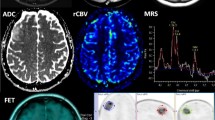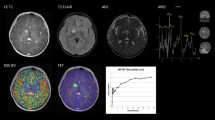Abstract
We describe the case of 74-year-old-male, previously treated with fronto-parietal craniotomy due to primary glioblastoma multiforme (GBM), followed by concurrent radiation therapy (RT) and temozolomide (TMZ) chemotherapy. Magnetic resonance imaging (MRI) of the brain, at 1 month after completing RT + TMZ, depicted partial response. Three months later, the patient was submitted to a further brain MRI, that resulted doubtful for therapy induced changes (i.e., pseudoprogression). The patient, who had been previously treated with prostatectomy for prostate cancer (PC), underwent a positron emission tomography/computed tomography (PET/CT) scan with 18F-choline for PC biochemical recurrence. 18F-choline whole body PET/CT resulted negative for PC relapse, while segmental brain PET, co-registered with MRI, demonstrated increased tracer uptake corresponding to tumor boundaries. In order to solve differential diagnosis between pseudoprogression and GBM recurrence, brain PET/CT with 18F-L-dihydroxy-phenil-alanine (18F-DOPA) was subsequently performed: fused axial PET/MRI images showed increased 18F-DOPA incorporation in the peri-tumoral edema, but not in tumor boundaries, consistent with the suspicion of GBM pseudoprogression, as then confirmed by clinical and radiological follow-up.






Similar content being viewed by others
Data Availability
Not applicable.
References
Stupp R, Mason WP, van den Bent MJ, Weller M, Fisher B, Taphoorn MJB, et al. Radiotherapy plus concomitant and adjuvant temozolomide for glioblastoma. N Engl J Med. 2005;352:987–96.
Shaffer A, Kwok SS, Naik A, Anderson AT, Lam F, Wszalek T, et al. Ultra-high-field MRI in the diagnosis and management of gliomas: a systematic review. Front Neurol. 2022;13: 857825.
Chawla S, Bukhari S, Afridi OM, Wang S, Yadav SK, Akbari H, et al. Metabolic and physiologic magnetic resonance imaging in distinguishing true progression from pseudoprogression in patients with glioblastoma. NMR Biomed. 2022;35:e4719.
Santo G, Laudicella R, Linguanti F, Nappi AG, Abenavoli E, Vergura V, et al. The utility of conventional amino acid pet radiotracers in the evaluation of glioma recurrence also in comparison with MRI. Diagnostics (Basel). 2022;12:844.
Kong Z, Zhang Y, Liu D, Liu P, Shi Y, Wang Y, et al. Role of traditional CHO PET parameters in distinguishing IDH, TERT and MGMT alterations in primary diffuse gliomas. Ann Nucl Med. 2021;35:493–503.
Law I, Albert NL, Arbizu J, Boellaard R, Drzezga A, Galldiks N, et al. Joint EANM/EANO/RANO practice guidelines/SNMMI procedure standards for imaging of gliomas using PET with radiolabelled amino acids and [18F]FDG: version 1.0. Eur J Nucl Med Mol Imaging. 2019;46:540–57.
Gerstner ER, McNamara MB, Norden AD, LaFrankie D, Wen PY. Effect of adding temozolomide to radiation therapy on the incidence of pseudo-progression. J Neurooncol. 2009;94:97–101.
Thust SC, van den Bent MJ, Smits M. Pseudoprogression of brain tumors: pseudoprogression of Brain Tumors. J Magn Reson Imaging. 2018;48:571–89.
Palumbo B, Angotti F, Marano GD. Relationship between PET-FDG and MRI apparent diffusion coefficients in brain tumors. Q J Nucl Med Mol Imaging. 2009;53:17–22.
Gómez-Río M, Testart Dardel N, Santiago Chinchilla A, Rodríguez-Fernández A, Olivares Granados G, Luque Caro R, et al. 18F-Fluorocholine PET/CT as a complementary tool in the follow-up of low-grade glioma: diagnostic accuracy and clinical utility. Eur J Nucl Med Mol Imaging. 2015;42:886–95.
Filippi L, Schillaci O, Bagni O. Recent advances in PET probes for hepatocellular carcinoma characterization. Expert Rev Med Devices. 2019;16:341–50.
Gao L, Xu W, Li T, Zheng J, Chen G. Accuracy of 11C-choline positron emission tomography in differentiating glioma recurrence from radiation necrosis: a systematic review and meta-analysis. Medicine. 2018;97: e11556.
Galldiks N, Law I, Pope WB, Arbizu J, Langen K-J. The use of amino acid PET and conventional MRI for monitoring of brain tumor therapy. Neuroimage Clin. 2017;13:386–94.
Treglia G, Muoio B, Trevisi G, Mattoli MV, Albano D, Bertagna F, et al. Diagnostic performance and prognostic value of PET/CT with different tracers for brain tumors: a systematic review of published meta-analyses. Int J Mol Sci. 2019;20:E4669.
Chiaravalloti A, Fiorentini A, Villani V, Carapella C, Pace A, Di Pietro B, et al. Factors affecting 18F FDOPA standardized uptake value in patients with primary brain tumors after treatment. Nucl Med Biol. 2015;42:355–9.
Bolcaen J, Descamps B, Deblaere K, Boterberg T, De Vos PF, Kalala J-P, et al. (18)F-fluoromethylcholine (FCho), (18)F-fluoroethyltyrosine (FET), and (18)F-fluorodeoxyglucose (FDG) for the discrimination between high-grade glioma and radiation necrosis in rats: a PET study. Nucl Med Biol. 2015;42:38–45.
Brindle KM, Izquierdo-García JL, Lewis DY, Mair RJ, Wright AJ. Brain tumor imaging. J Clin Oncol. 2017;35:2432–8.
Verburg N, Koopman T, Yaqub M, Hoekstra OS, Lammertsma AA, Schwarte LA, et al. Direct comparison of [11C] choline and [18F] FET PET to detect glioma infiltration: a diagnostic accuracy study in eight patients. EJNMMI Res. 2019;9:57.
Jabeen S, Arbind A, Kumar D, Singh PK, Saini J, Sadashiva N, et al. Combined amino acid PET-MRI for identifying recurrence in post-treatment gliomas: together we grow. Eur J Hybrid Imaging. 2021;5:15.
Author information
Authors and Affiliations
Contributions
LF was responsible for the idea. LF, AS, and BP wrote the manuscript. OB was responsible for PET/CT execution. BP performed PET/MRI co-registration and fusion. OS supervised the paper. All authors read and approved the final manuscript.
Corresponding author
Ethics declarations
Conflict of Interest
Luca Filippi, Angela Spanu, Oreste Bagni, Orazio Schillaci, and Barbara Palumbo declare no conflict of interest.
Ethics Approval and Consent to Participate
All procedures performed in studies involving human participants were in accordance with the ethical standards of the institutional and/or national research committee and with the 1964 Helsinki declaration and its later amendments or comparable ethical standards.
Consent for Publication
Written consent has been obtained from the participant for the anonymized use of data for research purpose.
Additional information
Publisher's Note
Springer Nature remains neutral with regard to jurisdictional claims in published maps and institutional affiliations.
Rights and permissions
About this article
Cite this article
Filippi, L., Spanu, A., Bagni, O. et al. Imaging Findings of 18F-Choline and 18F-DOPA PET/MRI in a Case of Glioblastoma Multiforme Pseudoprogression: Correlation with Clinical Outcome. Nucl Med Mol Imaging 56, 245–251 (2022). https://doi.org/10.1007/s13139-022-00758-2
Received:
Revised:
Accepted:
Published:
Issue Date:
DOI: https://doi.org/10.1007/s13139-022-00758-2




